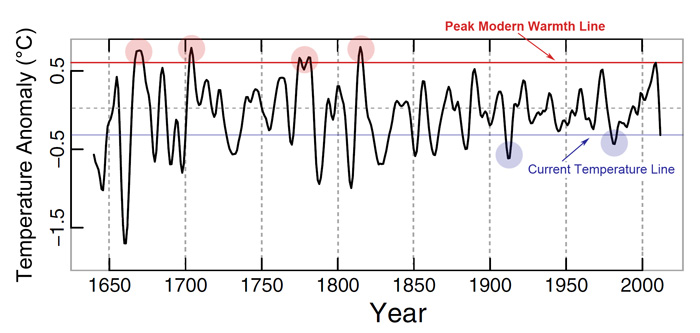| Tweet | Follow @co2science |
Paper Reviewed
Thapa, U.K., Shah, S.K., Gaire, N.P. and Bhuju, D.R. 2015. Spring temperatures in the far-western Nepal Himalaya since AD 1640 reconstructed from Picea smithiana tree-ring widths. Climate Dynamics 45: 2069-2081.
In the past two decades, much scientific research has been conducted to examine the uniqueness (or non-uniqueness) of Earth's current climate in an effort to discern whether or not rising atmospheric CO2 concentrations are having any measurable impact. Recent work by Thapa et al. (2015) adds to the growing list of such studies with respect to temperature.
According to this team of Nepalese and Indian researchers, the number of meteorological stations in Nepal are few (particularly in the mountain regions) and sparsely distributed across the country, making it "difficult to estimate the rate and geographic extent of recent warming" and to place it within a broader historical context. Thus, in an attempt to address this significant data void, Thapa et al. set out "to further extend the existing climate records of the region."
The fruits of their labors are shown in the figure below, which presents a nearly four-century-long (AD 1640-2012) reconstruction of spring (Mar-May) temperatures based on tree-ring width chronologies acquired in the far-western Nepalese Himalaya. This temperature reconstruction identifies several periods of warming and cooling relative to its long-term mean (1897-2012). Of particular interest are the red and blue lines shown on the figure, which demark the peak warmth experienced during the past century and the temperature anomaly expressing the current warmth, respectively. As indicated by the red line, the warmest interval of the 20th century is not unique, having been eclipsed four times previous (see the shaded red circles) in the 373-yr record -- once in the 17th century, twice in the 18th century and once in the nineteenth century. Furthermore, the blue line reveals that current temperatures are uncharacteristically cold. Only two times in the past century have temperatures been colder than they are now!

Figure 1. Reconstructed spring (March-May) temperature anomalies of the far western Nepal Himalaya, filtered using a smoothing spline with a 50 % frequency cut off of 10 years. The red line indicates the peak temperature anomaly of the past century, the blue line indicates the current temperature anomaly, the shaded red circles indicate periods in which temperatures were warmer than the peak warmth of the past century, and the shaded blue circles indicate periods during the past century that were colder than present. Adapted from Thapa et al. (2015).
In light of the above facts, it is clear there is nothing unusual, unnatural or unprecedented about modern spring temperatures in the Nepalese Himalaya. If rising concentrations of atmospheric CO2 are having any impact at all, that impact is certainly not manifest in this record.
Posted 29 January 2016



